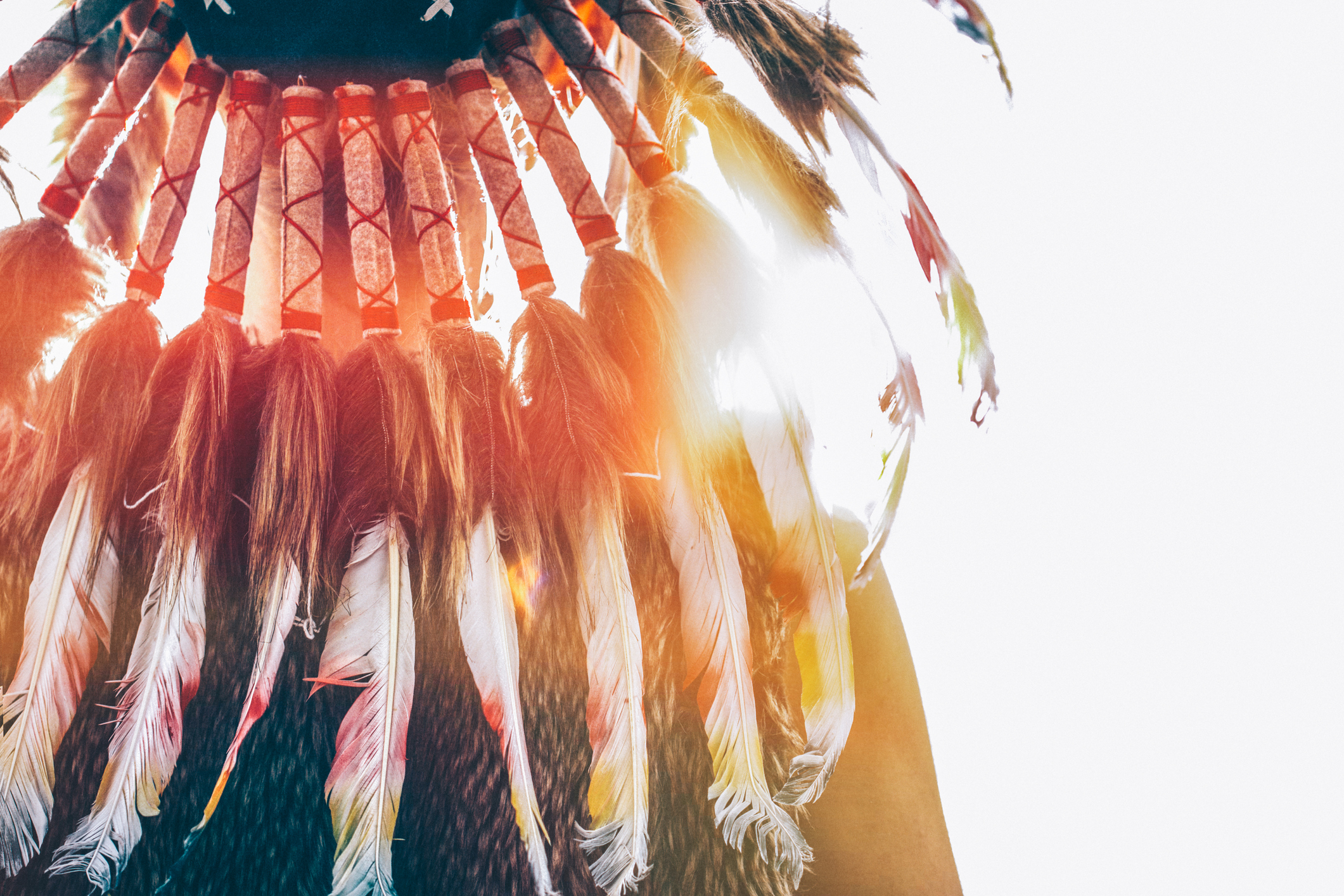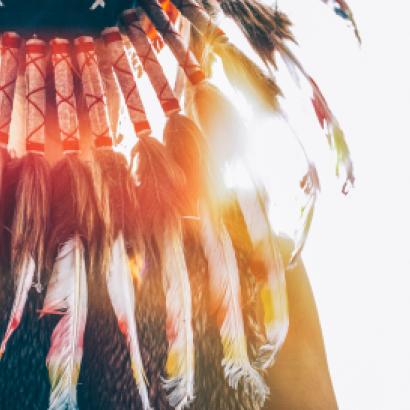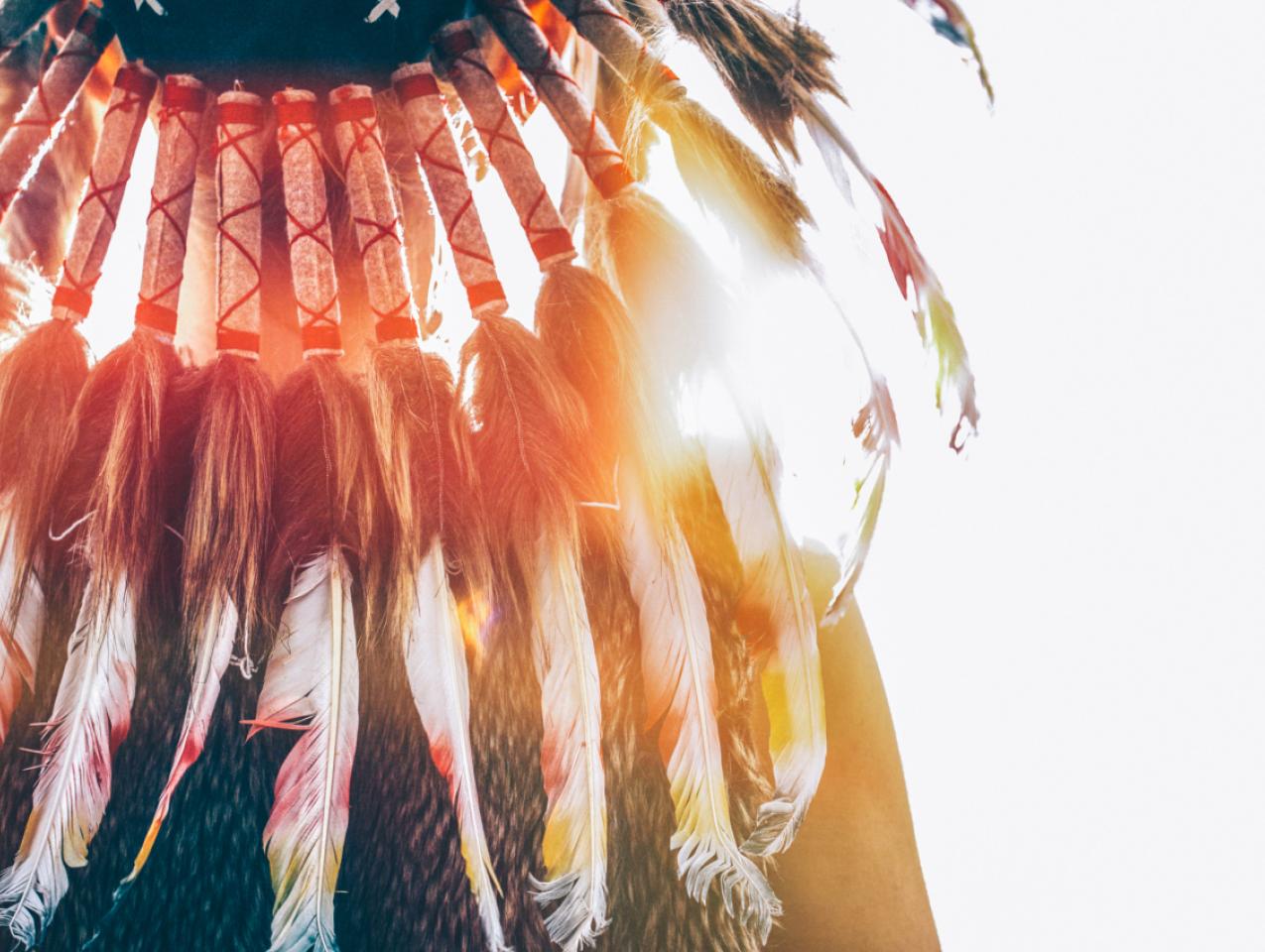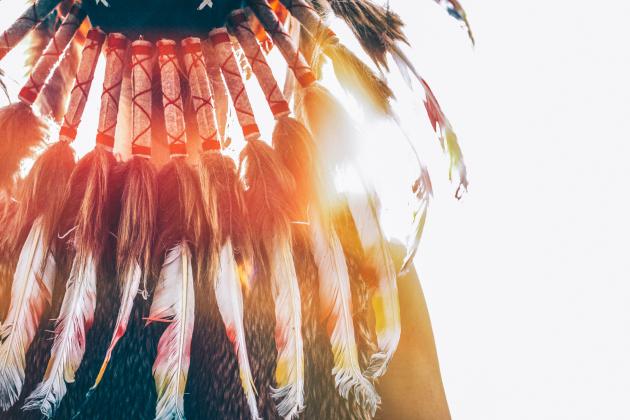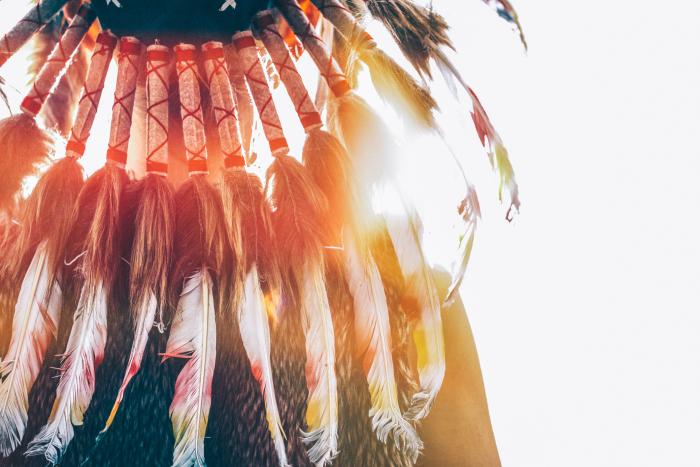Let me be a free man, free to travel, free to stop, free to work, free to trade where I choose, free to choose my own teachers, free to follow the religion of my fathers, free to talk, think and act for myself — and I will obey every law or submit to the penalty. Chief Joseph, Washington, D.C., 14 January 1879
From protests and politics, to pop culture, Americans have begun to pay more attention to the continent’s indigenous peoples. The recent PBS series Native America offers a glimpse of the advanced civilizations that existed before European contact. The documentary film Rumble finally gives Native Americans “credit for influencing a vast amount of popular music.” A record number of Native American candidates were on mid-term ballots across the country, and Kansas and New Mexico elected the first two Native American women to the U.S. Congress. To recognize “the remarkable legacies and accomplishments of Native Americans,” as Senator John Hoeven (R-ND) put it, the Senate passed its annual resolution declaring Native American Heritage Month. The legislation’s co-sponsor, Senator Tom Udall (D-NM), described Native American Month as an opportunity to “celebrate the indelible mark that Native American arts, languages, cultures, and peoples have left on New Mexico and the United States.” The emphasis on language, culture, art, and religion is integral to Native American heritage. But Native American heritage is not just about language and song; that heritage is also about the institutions that once governed and even now could help govern Native American daily lives.
This is the first of three essays aimed at a better understanding of how Native American heritage provides a foundation on which tribes can renew their economies with far less dependence on the “siren call of federal handouts,” as Alvin “A.J.” Not-Afraid, Chairman of the Crow Tribe, puts it. Honoring that heritage begins with realizing that “old indigenous economies” were built of tribal jurisdiction, governance structures, property ownership, and trade. Unfortunately, old indigenous economies were supplanted with “colonial indigenous economies” (essay 2) that made tribes and individual Indians wards of the state. Extracting themselves from colonial bondage will require “renewing indigenous economies” (essay 3) by clearly defining tribal jurisdictions, establishing new governance structures built on a rule of law and tribal heritage, and securing property rights (both collective and individual) that help tribes fully participate in and benefit from the modern, global economy.
Prior to European contact, indigenous economies were based on institutions that allowed American Indians to thrive rather than simply survive. In fact, as historian Amy Sturgis has observed, “far from primitive or forgotten, the New World’s indigenous legacy of individual liberty, limited government, and legitimate law offer insights as fresh and relevant as the new millennium.” Old indigenous economies are an example of “ideas defining a free society.”
Jurisdiction and Governance Structures
We generally refer to a group of Native Americans as a tribe because, as described by the Oxford English Dictionary, they are “a traditional society consisting of families or communities linked by social, economic, religious, or blood ties, with a common culture and dialect, typically having a recognized leader.” Like most social groups, Indian tribes, whether sedentary or nomadic, defined a geographic territory over which they had jurisdiction and from which they could enjoy nature’s bounty. Of course, there were conflicts, but tribes generally recognized and respected who controlled what.
Sedentary tribes from all parts of North America recognized the importance of property ownership. Clans, families, and individuals in eastern tribes owned land and could transfer that ownership, giving them the incentive to invest in their land by cultivating fields, propagating vegetation, and managing wildlife. Similarly, Pacific Northwest tribes dependent on the ocean’s bounty had property ownership of clam gardens, which were sections of beach where rocks and sand were moved to create terraces that encouraged clams to thrive. Southwestern tribes had corn fields with the boundaries clearly marked by stones indicating who owned the land.
The Iroquois Confederacy offers an excellent example of an agreement among governing tribes to avoid the zero-sum nature of fighting over territories and to organize, if necessary, to repel those attempting to violate established jurisdictions. Indeed, the Founding Fathers derived some of their ideas from this forward looking inter-tribal compact.
Even the more nomadic tribes of the Plains and Mountain West had tribal territories within which they could hunt, trap, and fish, and into which other tribes were reluctant to enter without permission. Tribes laid claims to hunting territories, drew boundary lines delineated by topographic features or boulders wrapped in buffalo hides, and signed treaties establishing what today we would call jurisdiction. Some tribes established rights to bear- and goat-hunting areas, berry and root patches, hot springs, and even trade routes.
Within tribes and their jurisdictions, old indigenous economies were organized by governance structures—rules of law—that determined leadership, rules for collective actions, and laws for resolving disputes. In a paper titled “Northern Cheyenne Tribe: Traditional Law and Constitutional Reform,” Sheldon Spotted Elk eloquently describes the importance of the sun dance as a way of passing along tribal governance structures and tribal law.
The Cheyenne governing system has been in existence for “centuries upon centuries, perhaps thousands of years” and goes to the core of our people’s existence and identity. In order to govern our people as Cheyenne in a post-Indian Reorganization Act (hereinafter “IRA”) period, we had to adapt our traditional governing structure and live under two constitutions and two governments, one traditional and the other a more western-based system. The main difference between the two systems is that the Western-based system is expressed through writing, secularism, individualism and majority rule, while the traditional system is oral, largely spiritual, tribal-based and consensus-oriented.
Pedestrian Indians—meaning before the arrival of European horses—who drove buffalo over cliffs offer another example of a well-developed governance structure. Before the horse, hunting buffalo was a large-group exercise involving 100 to 200 people needed to drive buffalo herds over cliffs known as buffalo jumps or piskuns. The collective effort was governed by a designated hunt leader who coordinated activities by appointing guards. The guards had the authority to punish anyone who disrupted the communal efforts by destroying the disrupter’s property.
In summary, Native American history prior to European contact is replete with examples of how indigenous jurisdiction and governance structures allowed Native Americans to go beyond survival to achieve prosperity. As James Robinson, co-author of Why Nations Fail, put it at a meeting of tribal leaders (September 24, 2018, Hoover Institution, Stanford University), “poverty and under-development are caused by societies having extractive institutions—institutions that fail to create broad-based incentives and opportunities in society.” This happens because nations have “extractive political institutions” that fail to broadly distribute political power or to establish a strong government based on the rule of law. Robinson concludes that
indigenous societies, in North America, in Australasia, had to deal with many of the same problems that Africans did. They suffered military conquest. They lost vast amounts of land. They did so in a context where their existing economic institutions were different from western ones. They had alien political institutions thrust upon them . . . . which often had the effect of creating centralized authority which had not previously existed. This has had a lot of enduring effects when it comes to try to change constitutions or institutions . . . . They still suffer from post-colonial meddling from the U.S. government.
Property Ownership
Just as Native American heritage should be celebrated for the ways in which tribes established jurisdiction over territories and governance structures for collective actions, it also should be celebrated for the legacy of property ownership. Movie versions of American Indian life—for example Dances with Wolves—depict communal societies where people adhered to the Marxian principle of “from each according to his ability, to each according to his needs.” Anthropological studies point to the contrary; Indians understood the link between ownership and productivity and conservation. As anthropologist Frank G. Speck put it, property ownership was linked to “the maintenance of a supply of animal and vegetable life, methods of insuring its propagation to provide sources of life for posterity, the permanent family residence within well-known and oftentimes blazed property boundaries, and resentment against trespass by the family groups surrounding them who possessed districts of their own.”
Personal property was nearly always privately owned because it required a significant investment of time to produce and maintain. Clothes, weapons, utensils, and housing were often the property of the women who made them. The teepee, for example, was owned by the women who collected the hides, tanned and scraped them, and sewed them together. The time it took to chip arrow heads and construct bows and arrows meant makers owned the fruits of their labor.
One of the best examples of property ownership comes from the Pacific Northwest, where Indians had well-defined fishing sites along the Columbia River. Because fish were naturally channeled at falls or shoals, Indians built fish wheels, and weirs—capital—that required significant investment and made it easier to harvest salmon returning from the ocean to spawn. Access to these locations and to the fixed appliances were limited to the clan or house group, which made the investment.
Pinon groves in the Great Basin were such an important food source that the groves were owned by families and could be traded. In one case a Northern Paiute reflected that his father “paid a horse for a certain pinon-nut range.”
By celebrating the Native American heritage of property ownership, we see that Native Americans developed institutions that encouraged resource stewardship. Far from societies based solely on communal organization, American Indians used property ownership—whether individual, family, or clan—to incentivize individuals to invest in capital assets that increased productivity. As a result they thrived even under sometimes harsh conditions.
Trade
Given their heritage of jurisdictions, governance structures (or rule of law), and property ownership, it is no surprise that American Indians took advantage of gains from trade. A favorite example is that of a trade axe made by Lewis and Clark’s blacksmith during the winter of 1805 in the Mandan villages of current-day North Dakota. These villages were among the most important trade nodes of the plains. Tribes from the north, south, east and west gathered in them to trade Pacific coast shells for Minnesota pipestone, dried buffalo for dried fish, and Yellowstone obsidian for caribou hide.
The Corps of Discovery used the trade axes to get food, horses, and other essentials for their trip west. After battling the upstream currents of the Missouri and crossing the Rocky Mountains, they arrived in the Nez Perce territory in the upper Columbia River basin only to find one of the trade axes had beaten them there. In short, it had been traded and traded again and again on its journey west.
By specializing in production and by tying production to property ownership, tribes throughout the Americas benefited from gains from trade. Trade allowed them to utilize new technologies—metal for cooking pots, for example—and expanded their art forms to incorporate materials such as beads for decorating clothing. Trade coupled with property ownership meant that what benefited one tribe benefited others.
Their Institutional Heritage
Long before Adam Smith penned The Wealth of Nations, Native Americans knew the source of wealth was more than nature; it was organizing themselves into productive societies. Not only were they rich in cultural ceremonies, language, songs, and art, they had cities such as Chaco Canyon. They were generally tall people as a result of highly nutritional diets, and if they survived infancy, they generally lived longer lives than most Europeans of the time. They generated new technologies, domesticated and refined seeds for cultivating crops, adapted to ever changing climactic conditions, and successfully adopted European resources such as the horse.
In summary, though today’s Native Americans are one of today’s poorest American minorities, they were not poor under “old indigenous economies.” Their modern poverty is the result of the “colonial indigenous economies” that rob American Indians of the freedoms articulated in the opening quote from Chief Joseph in 1879. “Renewing indigenous economies” means recognizing Native Americans’ rights to be American with their own jurisdiction, sovereignty, property ownership, and the freedom to trade. These are their heritage and they are the “ideas defining a free Native American society.”







